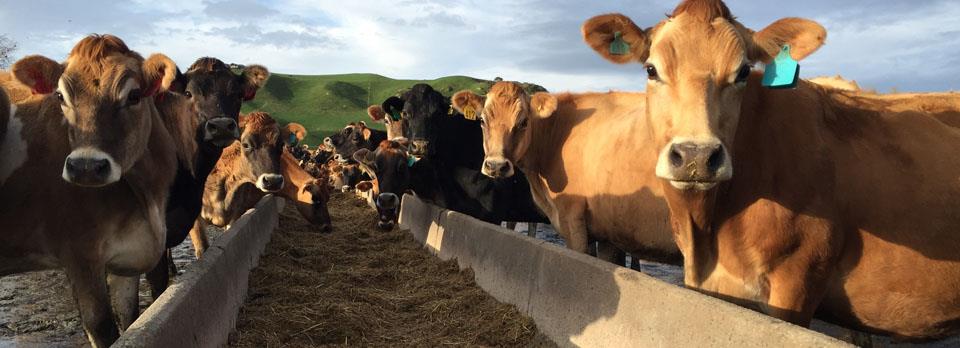
On so many farms the familiar smell of silage is the sickly cloying smell of butyric acid.
The same smell that gets you ordered to take a shower when you come in for breakfast after feeding out, the smell that makes most townies hold their noses. That smell has become so familiar over the years that many farmers naturally associate it to silage – it is prevalent across most farms during periods when silage is being fed. The funny thing is, good silage shouldn’t really have any smell at all. The familiar sickly smell is actually a sign of secondary fermentation that has caused butyric acid to form within the silage. And that smell is costing you money as it is a sign that the silage has lost some of its nutritional value. A good quality fermentation should be purely based on lactic acid, and lactic acid actually has very little smell.
WHAT’S GOING ON IN THE SILAGE?
As mentioned butyric acid is formed during secondary fermentation, produced by aerobic clostridial bacteria this fermentation is indicative of decomposition of the naturally formed (anaerobic) lactic acid. Aerobic fermentation degrades much of the original protein in the grass. Some farmers are naturally confused because butyric acid fermented silage is so common here in New Zealand they inherently associate the butyric acid smell to silage.
Added to this dilemma butyric acid fermented silage, while still being nutritionally degraded, can be very stable. Its high acidity levels can make it largely immune to moulds and any further degradation. However at this point the cost has already been paid, this butyric acid fermented silage has lost much of its protein as this has been used up during fermentation.
GOOD SILAGE MAKING IS A FINE ART.
Achieving good silage is dependent on many factors, most notably good timing and good technique. The other factor at play, and one that can sometimes turn a sub-standard crop, or one harvested in less than perfect weather conditions into silage that retains good feed quality, is technology. Provided the silage making technique is robust, a combination of high technology harvesting machinery and the use of a quality inoculant can make the difference between, a good quality silage, very ordinary silage, or at worst a real disaster. Of course when everything does come together perfectly, employing good technology in the form of a silage inoculant will insure an even better quality end product. New Zealand farmers have the ability to make silage that is equally as good as anything made on European farms, even bearing in mind that many European farmers treat silage making as a true artform.
In a perfect world, silage would be made when the crop can be harvested at its nutritional peak, the grass would be dried down to the perfect drymatter level, it would then be harvested with the best technology equipment available and then compressed into a concrete pit that is purpose designed to exclude all air with an airtight cover seal.
BUT CHALLENGES HAPPEN…
In reality the world is not this perfect and New Zealand weather conditions make it particularly hard during the harvesting season. Add to this problem, the fact that grass grows very fast here in New Zealand and at that time of the year there is often a shortage of available harvesting capacity. The result can be silage that is harvested at a less than optimal time. Weather conditions do dictate this and the drymatter level of the ensiled grass may not always be adequate due to crops having to be harvested within very tight weather windows.
THIS IS WHERE A HIGH TECHNOLOGY INOCULANT CAN MAKE ALL THE DIFFERENCE.
The use of the correct silage inoculant can secure a rapid lactic acid fermentation, achievable even under less than ideal conditions. With such technology, providing the air is kept out of the stack and integrity of the cover is uncompromised, a stable silage can be made that retains a high nutritional value.
The primary purpose of silage inoculants is an accelerated, controlled fermentation process, followed by higher fermentation quality and therefore enhanced nutrient and dry matter retention. Silage inoculants containing certain lactic acid bacteria, can also improve aerobic stability during feed out. This means the proper usage of silage inoculants is highly worthwhile from an economic point of view.
BONSILAGE is a silage inoculant being launched in New Zealand for the first time this year. Developed and manufactured out of Germany by Provita GmbH., it has been successfully used in Europe since 2000 and is now a worldwide leading range of high efficacy silage inoculants. BONSILAGE utilises unique, specifically selected living bacteria strains, formulated to produce superior forage quality under varying conditions.
The patented bacteria strains employed include L buchneri, which rapidly stabilises silage inhibiting yeasts and moulds, while reducing the risk of reheating and shrinkage. L planterum and L rhamnosus which quickly lower pH by producing lactic acid within the front end fermentation cycle. And L lactis to inhibit clostridia growth, lowering the risk of butyric acid forming in the higher moisture grass securing the latter end of the fermentation cycle.
Provita provide different blends that supply specific bacteria for different crops such as grass silage and maize silage, and also options when the crop must be harvested at higher moisture levels.
Using the correct BONSILAGE inoculant can measurably improve feed quality even in less than ideal silage making conditions. In perfect conditions with a good crop, these additives also have the ability to make good silage even better.
And of course creating less stink, could improve your marriage, lead to less showers, and who knows even happier, more energetic cows.
Article by Chris Balemi, Agvance Nutrition